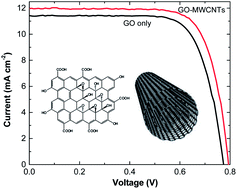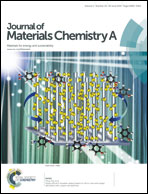Graphene oxide/multi-walled carbon nanotube nanocomposites as the gelator of gel electrolytes for quasi-solid state dye-sensitized solar cells
Abstract
The practical application of dye-sensitized solar cells (DSCs) requires high photovoltaic efficiency and good photovoltaic stability. This work reports nanocomposites of two-dimensional graphene oxide (GO) and one-dimensional multi-walled carbon nanotubes (MWCNTs) as the gelator of gel electrolytes for quasi-solid state DSCs. The composite gels are formed by immobilizing an organic solvent, 3-methoxypropionitrile (MPN), with GO and MWCNTs, and the gel electrolytes are prepared by adding iodine, 1-methyl-3-propylimidazolium iodide, guanidinium thiocynate and 4-tert butylpyridine into the GO–MWCNT–MPN composite gels. GO sheets can gel organic solvents because of their hydrophobic and hydrophilic domains. The MWCNTs can reinforce the solid networks formed by GO sheets and reduce the ionic diffusion length of the redox species within the electrolyte as MWCNTs are conductive and catalytic toward the electrochemical reduction of I3−. The presence of MWCNTs in the gel electrolyte increases both the open-circuit voltage (VOC) and the short-circuit current (JSC) of DSCs so as to increase the power conversion efficiency (PCE). The optimal PCE of the DSCs with GO–MWCNT–MPN gel electrolyte is 7.12% under AM 1.5G illumination (100 mW cm−2), which is significantly higher than that (6.54%) of the gel DSCs without MWCNTs.


 Please wait while we load your content...
Please wait while we load your content...